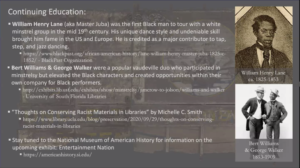Meeting Summary: “Facing Our Past: Conservation Treatment of a Theatrical Wagon Panel”
“Facing Our Past: Conservation Treatment of a Theatrical Wagon Panel” talk by:
Stephanie Guidera, Graduate Fellow at the National Museum of American History
Summary by: Emma Kimmel, Graduate Intern in the Department of Painting Conservation at the National Gallery of Art
Content Warning: The following passage describes racist literature and practices.
As part of the WCG’s Intern and Fellow Talks hosted on Zoom, Steph Guidera presented her treatment of a painted panel from a theatrical wagon housed at the National Museum of American History (NMAH). Her presentation not only detailed aspects of her treatment, but also provided context for the wagon panel’s use as part of a traveling minstrel show that was popular during the 19th century.
Guidera, after a land acknowledgement and statement of support for the Black Lives Matter movement, began her presentation by providing background for the wagon panel’s use. This panel is one of five from NMAH’s collection which detail different scenes from Harriet Beecher Stowe’s Uncle Tom’s Cabin, a best-selling novel from the 19th century that aimed to educate Northerner’s about the South and to humanize slaves. Although the problematic stereotyping and white saviorism of Stowe’s novel is obvious to modern readers, at the time the book was hugely popular throughout the United States. Due to its popularity, there were numerous productions of Uncle Tom’s Cabin, known as “Tom Shows,” running throughout the U.S.; in New England alone there were about 400-500 productions running between the 1850s-1930s. These performances were part of a larger trend of racist minstrel shows common at the time where predominately white people wore blackface to play the role of black people. The wagon panels owned by NMAH would have been part of a traveling performance of Uncle Tom’s Cabin, and used to transport actors and set pieces to different locations.
In the 1980s, shortly after their acquisition by NMAH, the panels were faced with tissue which totally obscured the underlying painted designs. Guidera’s first task was to remove this facing; although the facing adhesive was soluble in water, some of the binder in the fragile paint was water sensitive. After trying several different methods of removal, she decided to remove the facing using 5% Klucel G in ethanol. Any paint fragments that came up with the facing were consolidated and readhered to the panel with 10% Aquazol 500 in ethanol.
Once the facing was removed, the central image became more legible – a scene from Uncle Tom’s Cabin depicting one of the main characters Eliza running across the ice. Descriptive text “Uncle Tom’s Cabin.” and “___ Company” could also be read more clearly. However, removing the facing also revealed further condition issues: the full extent of loss throughout the design, and how little binder remained in the surviving paint layers. There was also significant dirt and debris, but this could not be addressed until the paint was adequately consolidated. 10% Aquazol 500 in ethanol was used to consolidate individual paint fragments, whereas a 5% solution was applied overall to areas with loose paint. Even after this local consolidation, the paint was so poorly bound that it was easily dislodged with light pressure, or would crumble to powder. Cleaning, therefore, was done selectively to those pigments stable enough. The most successful cleaning method Guidera tested was to clean the surface with cotton swabs using 3% triammonium citrate at pH 8, cleared with deionized water.
After consolidation and cleaning, there were still areas with powdering paint and a generally uneven surface saturation overall. Guidera therefore decided to varnish the entire panel, with the dual purpose of consolidating and evenly saturating the paint layers. As such, she applied a 15% Laropal K80 varnish in 1:4 xylenes : Stoddard solvent over the entire panel; due to the fragile state of object, reversibility was not prioritized in this case. There is still much work to do on these panels: addressing the structural stability of the wood and metal elements, creating appropriate display and storage mounts, and of course treatment of the other panels in the group.
Guidera ended this illuminating presentation with resources for continuing education (listed below) and informed audience members they can eventually see these wagon panels in person in NMAH’s upcoming exhibition Entertainment Nation (date TBD).
Resources for Continuing Education:
William Henry Lane (aka Master Juba) was the first Black man to tour with a white minstrel group in the mid-19th century. His unique dance style and undeniable skill brought him fame in the U.S. and Europe. He is credited as a major contributor to tap, step, and jazz dancing.
Bert Williams & George Walker were a popular vaudeville duo who participated in minstrelsy, but elevated the Black characters and created opportunities within their own company for Black performers.
“Thoughts on Conserving Racist Materials in Libraries” by Michelle C. Smith
Reposted from: https://washingtonconservationguild.org/2021/04/29/meeting-summaries-preservation-confederate-monuments-era-black-lives-matter-facing-past-conservation-treatment-theatrical-wagon-panel/


No comments:
Post a Comment